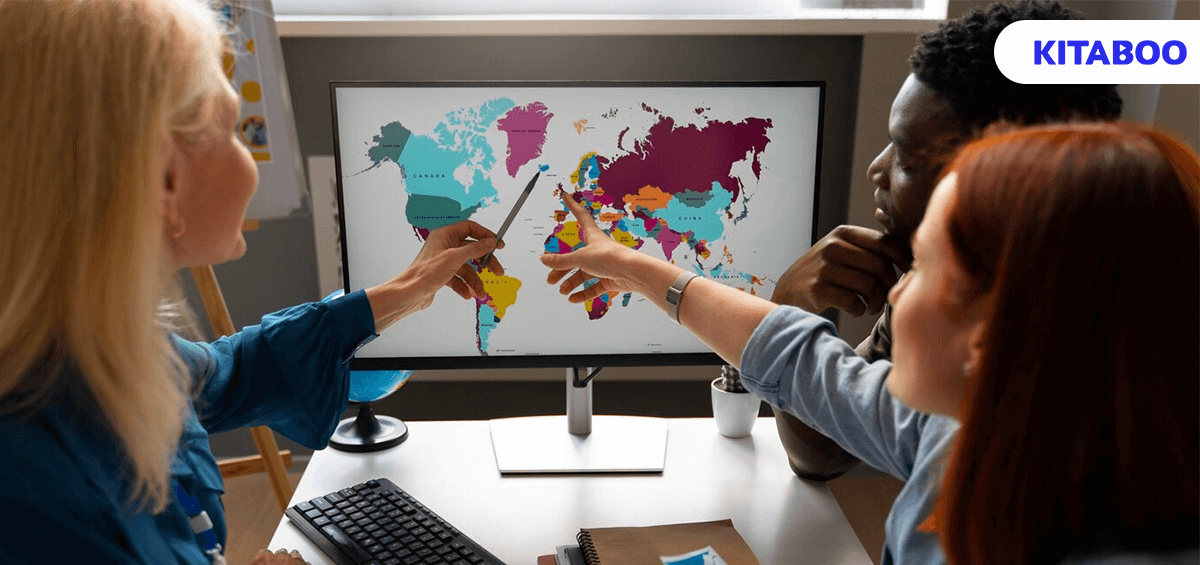Among all the subjects taught at school, social studies remains a challenge for most teachers to teach in an engaging way. While the subject revolves around human society and its functions, many students find the course content mundane, making them feel disengaged.
That said, technology has provided teachers with various innovative tools, like interactive learning materials and digital textbook platforms like KITABOO. These interactive tools help teachers drive higher engagement in classrooms.
It is possible to leverage many other forms of interactive teaching methods – like social studies simulations – to achieve the desired outcomes from a lesson. Let’s dive deep into social studies simulations and how they can drive higher engagement in the classroom.
Table of Contents
II. 5 Ways Interactive Simulations Make Social Studies More Engaging
IV. Wrapping Up
What is a Simulation?
Simulations are recreations of real-life scenarios. They can be:
- Created physically in classrooms by way of enacting plays or skits,
- Conducted virtually in online classroom live sessions
- Recreated in Augmented or Virtual Reality using artificial intelligence
Social studies topics can be easily taught using simulations created in virtual reality. Computer software can create scenarios and allow the participant to drive it using their response to the scenario. This exercise is especially helpful for students with a cautious approach toward speaking publically or interacting in group settings. Virtually simulated social scenarios provide them with the comfort they need to apply and polish their social skills.
The benefit of simulations is that they allow learners to actively control the lesson instead of being passive observers of the scene. Interactive simulations are thus able to drive a higher degree of engagement.
5 Ways Interactive Simulations Make Social Studies More Engaging
Simulations are fun for students. They get to experience a lesson in totality instead of sitting and listening to a social studies lecture. It removes the monotonous nature of “learning” social studies concepts by converting them into experiential activities. The five key ways social studies simulations enhance student engagement in a lesson are listed below.
1. In-Depth Understanding
Simulations promote an in-depth understanding of social studies concepts. Students can gain multiple perspectives of the same scenario, especially for topics that are impossible to experience (like a history lesson). For instance, events leading up to World War II can be simulated, enabling students to experience the perspectives of multiple political players.
The hardest challenge in social studies is the lack of proper experimentative learning methods, which makes simulations much more engaging. They enable teachers to deliver in-depth subject knowledge to the students.
Through simulations, it is possible to reproduce not just a social event but also the associated sentiment and morals to some extent. Students pay more attention in the classroom when a novel method, such as simulations, is used to deliver a lesson.
2. Behavior Management
Social studies simulations are designed to improve student participation in the curriculum by way of:
- Group activities in a virtual setting
- Scripted group activities in physical settings
- Scenario recreation in a virtual setting powered by software or AI.
When all the students in a classroom are engaged in learning through simulations, there are fewer behavioral problems that teachers are required to manage. Additionally, the high engagement generated during these simulations also works to help students manage each others’ behavior in a peer-to-peer way.
Teachers are able to identify the natural “leaders” and other attributes in students through having them engage in such simulations.
Simulations are an excellent way for students to learn social studies concepts beyond the surface level by interacting with each other or AI software and experiencing the lesson.
3. Enhanced Engagement
Simulations are extremely fun to be part of. Especially, because they take students away from the traditional learning mode where a teacher delivers a lecture to the entire class. With simulations, the students drive the lesson forward with their collective and individual inputs.
When the students can control how a lecture progresses and apply their own thinking and concepts to the situations presented, they remain engaged. Not only is this fun to learn, but it also creates higher engagement since the students are eager to participate and contribute their ideas to the pot.
4. Critical Thinking
Simulations are versatile tools that enable teachers to design custom scenarios to augment social studies lessons. This provides teachers an excellent opportunity to create social simulations with situations requiring students to apply critical thinking and respond to the scenario.
This creative approach toward social studies lessons generates student interest and improves engagement drastically. Additionally, simulations help students develop and hone their communication skills, cooperation, and problem-solving approaches to arrive at solutions.
Technology-driven lessons can help students become logical and reasoning adults by developing a thought process that factors in all the information available from the situation they are faced with.
5. Self-Motivation
Social studies is a subjective field; teachers must apply creative methods to teach to maintain students’ engagement and motivation to learn.
Simulations are excellent tools that teachers can use to keep students self-motivated to learn and engaged in the lesson. Teachers can design simulations where students are required to engage in role-playing activities. Such activities keep the students motivated to do their part, think on their feet, and apply their logical reasoning to the situation presented to them at hand.
Wrapping Up
Simulations – whether created physically or powered by technology – can be a great asset for teachers, especially in the case of social studies. For a subject that explores human interaction at a community level, it is important for the students to understand the concepts more through experience and demonstration than through lectures.
Educators can elevate social studies simulations with interactive content on digital textbook platforms like KITABOO. KITABOO enables teachers to design and easily create interactive learning material and deploy it over a variety of channels with ease. The handy integrations help them plug this content into simulations easily.
To know more, write to us at KITABOO@hurix.com.
Suggested Reads:
Discover How An Ebook Conversion, Publishing & Distribution Platform Can Help You
Kitaboo is a cloud-based content platform to create-publish & securely distribute interactive mobile-ready ebooks.
You May Also Like
-
Language Proficiency Assessment: Why It Matters
Blog,Digital Publishing,eBook solution / February 13, 2024









